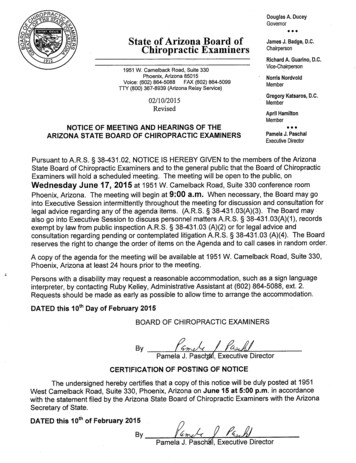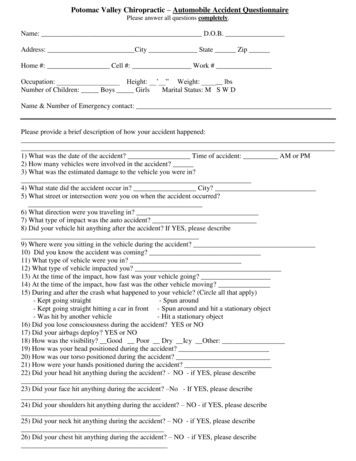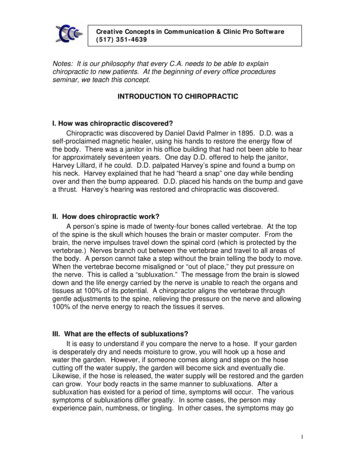
Transcription
Creative Concepts in Communication & Clinic Pro Software(517) 351-4639Notes: It is our philosophy that every C.A. needs to be able to explainchiropractic to new patients. At the beginning of every office proceduresseminar, we teach this concept.INTRODUCTION TO CHIROPRACTICI. How was chiropractic discovered?Chiropractic was discovered by Daniel David Palmer in 1895. D.D. was aself-proclaimed magnetic healer, using his hands to restore the energy flow ofthe body. There was a janitor in his office building that had not been able to hearfor approximately seventeen years. One day D.D. offered to help the janitor,Harvey Lillard, if he could. D.D. palpated Harvey’s spine and found a bump onhis neck. Harvey explained that he had “heard a snap” one day while bendingover and then the bump appeared. D.D. placed his hands on the bump and gavea thrust. Harvey’s hearing was restored and chiropractic was discovered.II. How does chiropractic work?A person’s spine is made of twenty-four bones called vertebrae. At the topof the spine is the skull which houses the brain or master computer. From thebrain, the nerve impulses travel down the spinal cord (which is protected by thevertebrae.) Nerves branch out between the vertebrae and travel to all areas ofthe body. A person cannot take a step without the brain telling the body to move.When the vertebrae become misaligned or “out of place,” they put pressure onthe nerve. This is called a “subluxation.” The message from the brain is sloweddown and the life energy carried by the nerve is unable to reach the organs andtissues at 100% of its potential. A chiropractor aligns the vertebrae throughgentle adjustments to the spine, relieving the pressure on the nerve and allowing100% of the nerve energy to reach the tissues it serves.III. What are the effects of subluxations?It is easy to understand if you compare the nerve to a hose. If your gardenis desperately dry and needs moisture to grow, you will hook up a hose andwater the garden. However, if someone comes along and steps on the hosecutting off the water supply, the garden will become sick and eventually die.Likewise, if the hose is released, the water supply will be restored and the gardencan grow. Your body reacts in the same manner to subluxations. After asubluxation has existed for a period of time, symptoms will occur. The varioussymptoms of subluxations differ greatly. In some cases, the person mayexperience pain, numbness, or tingling. In other cases, the symptoms may go1
Creative Concepts in Communication & Clinic Pro Software(517) 351-4639unnoticed except that the person is more susceptible to colds, tires more quicklyor starts having problems with an internal organ. Remember, the energy whichtravels down the spinal cord and through the nerves serves every area of thebody. Therefore, any area of the body can be affected by a subluxation.IV. When does the first subluxation occur?Often the first subluxation occurs at birth. Think of that fragile spine beingtwisted and turned as the doctor pulls the infant through the birth canal. Can youimagine how much trauma that causes? Learning to walk, riding bikes, andclimbing trees are often other causes of subluxations. Adolescents whoparticipate in sports also experience problems. As adults, there may be autoaccidents, work injuries or stress that affect the spine. Many of the activities ofdaily life can cause subluxations.V. How long will it take to heal?It all depends. Many times a subluxation has existed for a period of timebefore the person starts experiencing symptoms. The muscles of the spine haveadapted to the incorrect position of the vertebrae. For that reason, it may take aseries of adjustments before the muscles become accustomed to holding thevertebrae in the proper position. The muscles have to be retrained. It is almostlike playing tug-of-war with your body for a while. The doctor adjusts the spineand the muscles, ligaments and tendons pull it back out. Many patients will notseek chiropractic care until the symptom appears. By that time, the vertebra hasbeen misaligned for some time. That is why periodic spinal checkups are soimportant; prevention is the key to maintaining health.VI.What do chiropractors do?Let’s first understand what they don’t do. They will not prescribe drugs, performsurgery or treat symptoms. They find and correct the cause of the symptoms;that is, they find and correct subluxations.VII. How do they treat the cause?Chiropractors gently move the bones of the spine into place which relievesthe pressure on the nerve. When the spine is aligned, the body receives theenergy needed to heal itself naturally.2
Creative Concepts in Communication & Clinic Pro Software(517) 351-4639PATIENT EDUCATION OUTLINEI. Introduce yourself.II. History—D.D. Palmer, 1895; Harvey Lillard, janitor, hearing problem.III. Brain—master computer. Describe the relationship between the brain,vertebrae and nerves.IV. Subluxation. Describe subluxation. Your symptoms can be caused bya subluxation. Use hose analogy.V. When does a subluxation occur? Birth, activities of childhood, sports,work injuries, auto accidents, etc.VI. How long will it take to heal? Muscles have adapted to the improperposition. Series of adjustments will be needed until muscles get used to theproper position. Use tug-of-war example.VII. What do chiropractors do? They don’t prescribe drugs, performsurgery, or treat the symptoms. They correct the cause—subluxation.VIII.How do they treat the cause? Gentle movement of the vertebrae,taking pressure off nerves and allowing your body to heal itself naturally.IX. Any questions?3
Creative Concepts in Communication & Clinic Pro Software(517) 351-4639Note: While the doctor is explaining chiropractic to parents in a lay lecture, wesuggest that the C.A. explain chiropractic to the children. This encourages familycare.LAY LECTURE FOR KIDSTonight while the doctor talks to your parents, I’m going to talk with youabout Spenser the Spine. Have you ever heard of Spenser the Spine? He’sreally special and I want you to meet him. Look at what I’m holding. This is aspine. You have one just like this inside every one of you. Some people call it abackbone. It’s right back here. (Touch someone’s back)Let’s look at Spenser the Spine really close. See these hard bones? Wecall them vertebrae. Can you say “vertebrae” with me? These hard bones,vertebrae, have a hole in the middle. Your spinal cord runs through that hole.This spinal cord is made of things we call nerves. Move your fingers for me. Doyou know that you can move your fingers because you have nerves? Your brainsays “Move your fingers.” This message travels down your spinal cord and outthrough nerves that go right to the very tips of your fingers.These nerves are very important. Everything you do depends on yournerves. When you run, it is because your brain tells your legs to move. Whenyou ride bike, your brain is sending messages through the nerves telling yourlegs how to pedal. These bones, the vertebrae, protect the spinal cord so yourlegs get the right message. Can you imagine what would happen if your brainsaid “run” and your arms moved instead of your legs? You wouldn’t get very far,would you?Sometimes these vertebrae get out of place, they move where theyshouldn’t. Sometimes they even move like this and pinch a nerve. Do you knowwhat happens then? It can hurt real bad. These nerves are softies. They don’tlike having a hard bone resting on them. It hurts. Our doctor here is trained toknow when these vertebrae get out of place and put them back where theybelong. He (she) is trained to fix “subluxations.” That’s a big word, isn’t it?That’s what it’s called when the vertebrae get out of place and pinch the nerveslike this. Can you say “subluxation” with me—let’s say it slowly. Subluxation.Subluxation. Very good! Now you can tell your mommy and daddy aboutsubluxations.What do you think makes these vertebrae move and pinch nerves? Haveyou ever fallen off your bike? You can hurt your back and not even know it. Youcan have a subluxation from it. What else have you done that hurt? (Let themtell you stories) That could cause a subluxation, couldn’t it? You bet. If youdon’t have the doctor check your spine occasionally, you could have lots ofsubluxations by the time you get as old as your mommy and daddy.4
Creative Concepts in Communication & Clinic Pro Software(517) 351-4639What does our doctor do? Does he/she give you shots? No! Does he/shegive you pills to take? No way. Does he/she work on your teeth? Nope, that’s adentist. Does he/she put you in the hospital? No! Our doctor puts you on atable and uses his/her hands to find these vertebrae that are out of place. Thenhe/she puts them back where they belong so these nerves don’t get sick andmake you sick. Our doctor looks for subluxations and fixes them.So let’s see how much you remember. What’s this bone called? Vertebra.What’s this (yellow-green-or whatever color) thing called? Nerve. What’s itcalled when this vertebra moves out of place like this and pinches a nerve?Subluxation. What kinds of things can cause subluxations? Falling off bikes,falling out of trees, getting hit with a ball, getting in a fight, etc. What does ourdoctor do to make sure you don’t have a subluxation? He/she checks your spineto see if the vertebra are out of place and gently moves them back into place.5
Creative Concepts in Communication & Clinic Pro Software(517) 351-4639THE ROLE OF THE CHIROPRACTIC ASSISTANTAn assistant is someone who helps or assists another person. In thiscase, the chiropractic assistant assists the chiropractor in the two criteria for asuccessful office: patient management and office management. The C.A. maybe actively involved in patient care by performing such tasks as a new patientinterview, education of the patient, performing an exam, taking x-rays, etc. Thechiropractic assistant also aids with office management by using the telephone tomake appointments, collecting money, billing insurance companies andperforming many other related tasks. Since a new patient’s impression of theoffice is formed by the initial contact, the role of the chiropractic assistant isextremely important in developing a good first impression. There are five keyingredients that comprise a good FIRST impression. They are:F FriendlyTrustworthyI IntelligentR ResourcefulS Self-disciplinedT To become first in the patient’s eyes, the C.A. must be friendly. Learnpatient names quickly and greet each patient by name. Train yourself toremember previous conversations with a patient and refer to them in yoursubsequent contacts. Show a sincere and friendly interest in each patient as anindividual. Next, a C.A. must be intelligent. When a patient asks questions aboutchiropractic, the C.A. should answer them with ease. Problems with insuranceshould be handled with tact and understanding. An intelligent C.A. is able toshare knowledge in a clear, concise manner which encourages the patient to askfurther questions until the answer is fully understood. A chiropractic assistantmust be resourceful. According to the definition, a resourceful person is able todeal promptly and effectively with problems. Situations will arise when a patienthas to wait an excessive length of time for an appointment; the ability toempathize with the patient and deal with the wait is a key to success. Selfdiscipline is a necessary ingredient to achieving the ultimate performance in anyjob. It often involves doing things when you don’t feel like doing them. Theremay be times when it is difficult to call patients with delinquent accounts orpatients who have missed appointments. Self-discipline distinguishes themediocre C.A. from the truly exceptional one. Finally, a C.A. must be trustworthy.By choosing your office for chiropractic care, the patient has entrusted his/hermost valuable possession, health, to your hands. In addition, the doctor istrusting you to protect and promote his/her business. In both cases, the amountthe trust involved is enormous. Your doctor knows and understands theimportance of a good FIRST impression or you would not be reading thismaterial.6
Creative Concepts in Communication & Clinic Pro Software(517) 351-4639PATIENT PROCESSINGThe chiropractic assistant is responsible for directing the flow of the office,making sure that adjusting rooms are kept filled, appointments scheduled andfunds collected. There is a pattern that emerges which will keep the flow evenand productive. A typical method of patient processing is listed.1. As soon as the patient enters the office, look up from your work and greethim/her.2. When an adjusting room is available, the patient should be directed intothe room. In most cases, the chiropractic assistant will actually lead the personto the room. To get cooperation quickly, you might say:“(Patient’s Name), follow me please.”Avoid using phrases such as “Would you come with me, please?” Thisphrase could be answered with a negative response, causing an unnecessarydelay.3. If the patient wears glasses or has earrings which will be in the doctor’sway, suggest that the patient allow you to put them aside for safekeeping.“Mrs. Jones, if you’ll hand me your glasses, I’ll put them over here untilyou have had your adjustment.”4. After the patient has been adjusted, he/she should come to the frontdesk. The first responsibility is the scheduling of the next appointment.“Mrs. Jones, when did Dr. (Last Name) want to see you again?”5. Once the appointment is scheduled, the fee should be collected.“Mrs. Jones, your charge today is 35. Will that be cash or check?”6. When the money has been collected and the receipt given to the patient,the date of the appointment can be confirmed.“We’ll see you on Monday. Have a nice weekend.”7
Creative Concepts in Communication & Clinic Pro Software(517) 351-4639PATIENT CONFIDENTIALITYPatient confidentiality is a very important part of the doctor-patientrelationship. A
Chiropractic was discovered by Daniel David Palmer in 1895. D.D. was a self-proclaimed magnetic healer, using his hands to restore the energy flow of the body. There was a janitor in his office building that had not been able to hear for approximately seventeen years. One day D.D. offered to help the janitor, Harvey Lillard, if he could. D.D. palpated Harvey’s spine and found a bump on his .
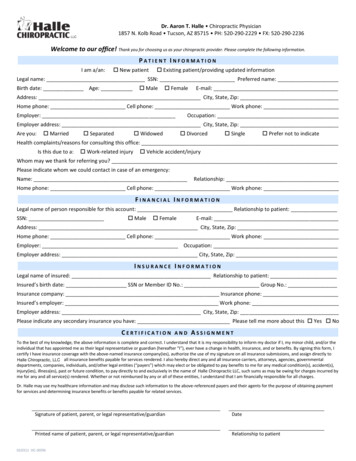
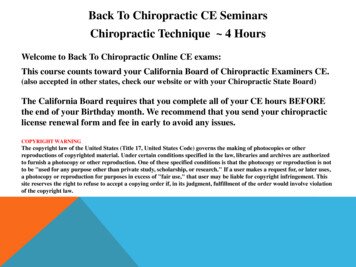

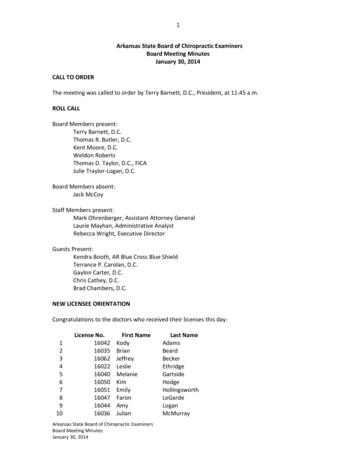

![Tier 1 Chiropractic Directory [as of April 2018]](/img/8/chiropractic-tier1.jpg)
